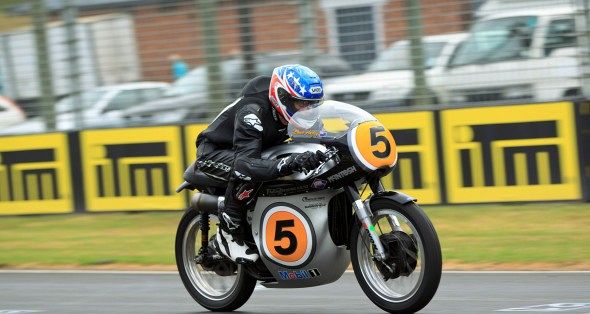Fancy yourself a proper motorbike rider? Good on ya, mate. That’s why your trackday screamer has electronic suspension dialed in by Flamenco B. Crouch. Carbon bodywork. A quickshifter. Traction control, wheelie control, and 10 power modes. Tire warmers. And datalogging that streams to Facebook via smartphone from Brass Balls Raceway.
Well, this New Zealand-built 1962 Norton Manx replica can’t boast any of that. It has one archaic air-cooled cylinder. Granddad’s drum brakes instead of six-piston monoblocks. A handmade steel frame and something called a Roadholder fork. Replacing multifunction instrumentation is a mechanical rev counter. And oh, there are only two wires: one in the magneto and another for the spark plug. Silly old thing.
However, this motorcycle is more than appearances suggest, and given the chance, it might just change your impression of “old bikes” forever. Last summer, Bruce Anstey rode it to victory in the GP1 class at the Isle of Man Classic TT, winning the Hailwood Trophy with a fastest lap of 108.1 mph, the best ever for a Norton Manx.
There are clues, if you look. Instead of the 7,000-rpm redline common for singles of the period, the redline is set at 8,600 rpm. It has smaller 18-inch wheels, a short, high exhaust, a close-ratio six-speed TT Industries gearbox, and 92mm-bore/short-stroke dimensions. Builder Ken McIntosh refused to discuss the output of its British-built Summerfield engine, but it’s likely close to 60 hp.
Even before it won at the IoM, this bike had history. McIntosh built it for himself but soon realized it needed a better rider. That led to races with Kevin Schwantz, Andrew Stroud, Cameron Donald, Doug Polen, and finally Anstey aboard. To date it’s won 35 of 49 races entered.
So what is a Featherbed Manx, anyway? Built in Birmingham from 1950 to ’62 in 350 to 500cc sizes, this was Norton’s GP-spec racebike. Its unmistakable advantages were the rock-solid handling of the new double-cradle frame and swingarm rear suspension, the robust DOHC engine, and extremely high component quality.
The Manx is long and low, and you sit well back in the cockpit, with your bum over the rear wheel. But there are scallops in the tank for wrists and knees, so you can tuck behind the Avon-style fairing. McIntosh converted this bike’s right-side gearshift to the left, with a one-up, five-down racing pattern. The four leading-shoe magnesium front brake, single leading-shoe magnesium rear brake, and dry clutch are all cable operated and have a decidedly mechanical feel.
Details include needle bearings for the swingarm, modified fork dampers, and Works Performance UltraLite titanium shocks. And yet McIntosh stayed true to the geometry and construction of the original Featherbed frames, which were oxyacetylene bronze-welded high-tensile steel.
There is no ignition switch or starter button. At Pukekohe Raceway near Auckland I turn on the petcock and flood the Amal GP carb. The bike is not extremely light; weighing 320 pounds dry, it is typical for the day. Click it into first gear and back up on compression and then clutch in onto a roller starter. Then drop the clutch and a piston nearly the size of a small-block Chevy’s slams toward the roof of the two-valve combustion chamber, and the Lucas mag lights the avgas mixture. Wham! Suddenly I’m astride a bellowing, jangling, vibrating beast. The dry clutch spins near my left foot. Finally it’s ready to rev. Up for first, slip the clutch, and we ease down Pukekohe’s pit lane. A little more throttle and the entire bike now comes alive, like the orgasmatron in Woody Allen’s Sleeper. Then it’s go time.
Accelerating onto the front straightaway, the Manx hunkers down and lunges forward. Instantaneously, it evokes the feeling of a Ducati 851 superbike: stable, linear, and utterly on rails. There’s no upsetting this motorcycle. The “on rails” feeling continues into Pukekohe’s fast, right-hand turn one. You can’t scooch forward to load the front tire particularly, and the 27-degree rake doesn’t produce quite the response of a 600 supersport, but that’s just the kind of stability the Manx was designed to provide at the Isle of Man.
A quick left-right flick, which the Norton manages briskly, leads into Castrol Corner, a sharp right-hander leading onto the long back straight. Here the revs fall to 3,000 rpm, but amazingly the engine pulls to redline with nary a hiccup, despite the big 40mm carb. And the close-ratio tranny clicks off gears with a short throw and level effort reminiscent of a modern box. Without onboard data acquisition, it’s impossible to measure the performance, but an onboard camera of Anstey at the TT shows the tach hovering at nearly 8,000 rpm in top gear, suggesting maximum velocity is a bit north of 140 mph.
Scrubbing off that kind of speed isn’t difficult for modern sportbikes, but it takes more doing on the Manx. The lever effort on the four-shoe front brake is heavy, and it doesn’t telegraph nearly the feel of a good disc setup. Despite this, with the sticky Avons the Manx gets slowed down well enough for a right-left chicane at the end of the back straight.
Maybe the part of the Pukekohe circuit that really speaks to the Manx’s innate greatness is the last turn, a cresting right-hander—ringed by a concrete wall—that can unweight bikes as they’re fully leaned over. Getting it right is crucial for speed along the front straight and also for staying alive. The Manx leans over and laser-locks onto a line. In these critical few seconds, every message imparted through the grips, seat, and pegs communicates confidence and stability, which, together with speed and reliability, is what Anstey used to win the Hailwood Trophy and set a Norton Manx lap record.
Disclaimer. In harsh reality, any 20-year-old ZX-6R will surpass most of the Manx’s dynamic capabilities. But that isn’t really the point. The point is that in 1950, when Irishman Rex McCandless designed the works Manx’s Featherbed frame, copied faithfully here, he bloody well got it right. The point is that this IoM winner is arguably the highest expression of the quintessential English racebike, as well as a fully functional objet d’art. And the point is that even compared to today’s products, it is really exciting to ride.
You can’t buy Anstey’s winning bike, but McIntosh can build an exact copy that he calls the “Schwantz Spec” Manx. The cost is about $66,000 give or take. Take one ride and I can absolutely promise you, as Eric Burdon once sang, “It will be worth it.”












24
Comment